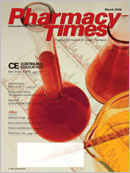Publication
Article
Pharmacy Times
Capsules for Inhalation May Be Mistaken for Oral Capsules
Author(s):
The Problem
When prescribing, dispensing, oradministering formoterol fumarate(Foradil Aerolizer) or tiotropium bromide(Spiriva HandiHaler), consider the distinctpossibility that these medications maybe swallowed mistakenly rather thaninhaled through their accompanyingdevices. Formoterol fumarate is a longactingbeta2 agonist used in the treatmentof asthma and chronic obstructivepulmonary disease (COPD), and tiotropiumbromide is an anticholinergic bronchodilatorused for COPD. Each medicationis available as a dry powder within acapsule, and the capsules are packagedin blister cards. When used correctly, thecapsule is removed from the blister cardand placed into the inhaler device. In thedevice, the capsule is punctured to allowthe medication to be dispersed into thelungs as the patient inhales through theinhaler mouthpiece.
Because capsule dosage forms usuallyare associated with oral administration,formoterol fumarate and tiotropium bromidehave been swallowed by mistake.The Institute for Safe Medication Practices(ISMP) has received numerousreports describing situations wherepatients have received these medicationsby the ineffective oral route. Mostof the reports have come from hospitalsand long-term care (LTC) facilities. A fewreports, however, have involved communitypharmacy patients.
Reports have cited the following contributingfactors:
Order communication—Prescriptionsmay be communicated ambiguously. Forexample, a prescription with the instructions"Foradil one capsule orally every 12hours" was received and dispensed by apharmacy. These instructions led thepatient to believe that the medicationwas to be swallowed. Also, medicationadministration records (MARs) may listthese medications along with other oralmedications. Such instructions oftenbegin with the phrase "1 capsule," leadingnurses to think that the product is anoral medication.
Education—Patients and practitionerswho are unfamiliar with this dosage formmay mistakenly administer the medicationorally.
Storage—These products may bestored along with other oral medicationsin patient homes or in medication drawersand automated dispensing cabinets inLTC facilities. If the inhaler device is separatedfrom the capsules, caregivers arelikely to assume (due to the dosage form)that the capsules are to be swallowed.
Packaging and labeling—Packaging issimilar to that of other oral unit-dosemedications, and blister labeling is inadequateto protect against oral use.
Safe Practice Recommendations
To prevent similar errors with thesemedications, consider the following:Products should be ordered andentered into computer systems as"Foradil Aerolizer" and "SpirivaHandiHaler" to better distinguish themedication when it prints out on apatient's MAR or pharmacy label.
Instructions for both patients and staffmembers must clearly express the needfor the medication to be inhaled: forexample, "Inhale the contents of onecapsule every 12 hours using Aerolizer."Avoid using instructions that begin with"One capsule?" or that include the word"oral," which may be misinterpreted. If aprescriber's instructions are nonspecific(eg, "1 capsule bid" or "use once daily"),pharmacists should express the instructionsin a manner that clearly states howthe medication is to be used.
Shortcuts could be programmed intocomputer systems to ensure that theseproducts are ordered and dispensedwith the proper instructions. For example,if the word "Spiriva" is entered in theinstructions field, the phrase "Inhale thecontents of 1 capsule once daily usingHandiHaler" would be printed.
Auxiliary messages stating "FOR USEONLY WITH INHALER. DO NOT SWALLOWCAPSULE" or "FOR INHALATION ONLY" should print out prominently on MARs.Similar auxiliary labels could be placedon boxes and blister labels to help differentiatethese capsules from other oralmedications that may be stored in thesame place. Otherwise, these productsshould be stored separately from oraldosage forms.
Patients, caregivers, and staff membersmust be educated regarding theproper administration of these medicationsbefore they are dispensed oradministered. Training kits containing aninhaler device, placebo capsules, andpatient education materials are availablefrom each manufacturer.
Capsules should be stored in the boxprovided along with the inhaler device.Do not dispense the capsules separately.In LTC facilities, put the patient's name onthe inhaler device to ensure that it isreturned to the correct patient's box ofmedication.
The manufacturers of both productsare aware of the errors that haveoccurred, and we at ISMP have askedthem to place a warning on the blistercards. The FDA also is aware of our concerns.These errors should serve as areminder that health professionals needto be very clear in their verbal and writteninstructions.
Dr. Kelly is the editor of ISMPMedication Safety Alert!Community/Ambulatory CareEdition.







